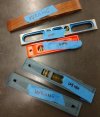Locutus D'Borg
Platinum Member
- Joined
- Dec 1, 2012
- Messages
- 5,222
Let me start by saying this is not a grenade I'm lobbing, so please don't take offense at my question.
Also, I will stipulate that following tradition is the obvious answer, but I have a custom slip joint made with Torx and like 3 others made with pins. I also own GECs and Case. I have noticed Boker uses Torx with some of their traditional. (sorry, I can't un-bold this part for some reason).
What I'm wondering is that modern knife buyers - even some who specialize in slip joints - may expect higher tolerances than in the past. Modern technology gives makers the ability to use tight tolerances and I was thinking that over time, traditional knives can "loosen up" a bit, which wouldn't bother me but might bother some. And screws give the option of tightening.
Also, pivots would be easier to adjust using a screw vs pin.
I have never made a knife so I don't know about pins per se, and I've personally never had a knife with an issue, although I''ve owned older slip joints that were a bit loose (pivot loosened over time).
Thoughts?
Also, I will stipulate that following tradition is the obvious answer, but I have a custom slip joint made with Torx and like 3 others made with pins. I also own GECs and Case. I have noticed Boker uses Torx with some of their traditional. (sorry, I can't un-bold this part for some reason).
What I'm wondering is that modern knife buyers - even some who specialize in slip joints - may expect higher tolerances than in the past. Modern technology gives makers the ability to use tight tolerances and I was thinking that over time, traditional knives can "loosen up" a bit, which wouldn't bother me but might bother some. And screws give the option of tightening.
Also, pivots would be easier to adjust using a screw vs pin.
I have never made a knife so I don't know about pins per se, and I've personally never had a knife with an issue, although I''ve owned older slip joints that were a bit loose (pivot loosened over time).
Thoughts?


